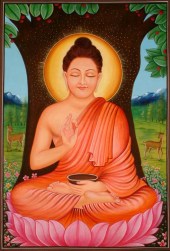This article is based on notes produced from Sean McCullough’s presentation to the Purdue polymath society on 20th of November, 2015.
*Disclaimer: This article is based exclusively on secondary/tertiary sources; do not rely on this for accurate information.
History of Buddhist meditation
Meditation is a very old practice that has been around for a long time, with earliest known records observed in Lascaux and Altamira cave paintings, dating back to the upper paleolithic era (BC 14000~18000) [1]. The oldest written record of meditation appears in the Hinduist Vedas, dating back to 1100~1700 BCE, with its practices and supposed implications extensively discussed in a class of text known as the Upanishads [2].

Perhaps the most widest form of meditation practiced, namely, that of Buddhist origin, was founded not so long after, roughly around 450 BC, when Siddharta Gautama, or the Buddha, paved the foundation for Buddhism. His choice to practice meditation wasn’t arbitrary; it had reasons deeply rooted to Buddha’s own course of life itself.
Siddharta Gautama was born a Kshatriya (political/military elite class) as a son to the chief of Shakya clan. It is said that his father completely sheltered Siddharta from the world as to ensure that he lives oblivious of suffering of any kind. He was raised in the palace surrounded by extensive care and wealth, and hadn’t once been to the outside world until he was 29. According to Buddhist scriptures, Siddharta later realised that material wealth is not the ultimate goal of life, a realisation that he very likely to have attained due to this period of wealth.
 At the age of 29, he goes out of his palace for the first time to meet his subjects. Despite his father’s effort to hide the sick, aged and the suffering from Siddharta, he encounters an old man, then a diseased man, then a decaying corpse, and lastly an ascetic. He was said to have been depressed by the suffering prevalent in the world, and decides to become an ascetic to overcome the sufferings [3].
At the age of 29, he goes out of his palace for the first time to meet his subjects. Despite his father’s effort to hide the sick, aged and the suffering from Siddharta, he encounters an old man, then a diseased man, then a decaying corpse, and lastly an ascetic. He was said to have been depressed by the suffering prevalent in the world, and decides to become an ascetic to overcome the sufferings [3].
However, even after mastering the teachings of many hermits, he remained unsatisfied, to the point he commits himself to self-mortification by depriving himself of wordly goods, including food. The idea behind this practice was that the body and the mind are in a balance, and when one is deprived, the other side will grow to reattain the balance. Therefore, he believed that by depriving himself of any worldly, bodily goods to the point of death, he will be able to attain the most complete spirituality. However, upon lingering to brink of day, he casts doubt to the idea and decides to reject asceticism.
 He believed that there had to be a ‘middle’ way between the extreme, self-depriving practices of asceticism and the worldly goods, and decides to meditate under a tree, now known as the Bodhi tree, until he reached enlightenment. His focus, then, was on overcoming suffering, without any consideration of metaphysical concerns. In the end, he does reach his enlightenment, and following the Buddha’s teachings, his students and the future Buddhists attempt to reach enlightenment through meditation.
He believed that there had to be a ‘middle’ way between the extreme, self-depriving practices of asceticism and the worldly goods, and decides to meditate under a tree, now known as the Bodhi tree, until he reached enlightenment. His focus, then, was on overcoming suffering, without any consideration of metaphysical concerns. In the end, he does reach his enlightenment, and following the Buddha’s teachings, his students and the future Buddhists attempt to reach enlightenment through meditation.
Because Buddhism didn’t have a united and strictly enforced doctrine overarching the entire practice, students were taught by the ways of their masters and then moved on to develop it themselves, passing down their unique teachings to their students. For this reason, Buddhism contains many variations that branch out from one another. The three major ‘categories’ of Buddhism is Vajrayana, from which the Tibetan Buddhism originates, Theravada, the root of Thai and Sri Lankan Buddhism, and Mahayana, which led to the most widely known Zen Buddhism that became prominent in China, Japan and Vietnam.
As Zen Buddhism spread, it picked up the cultural aspects of each region; for example, when Zen Buddhism was introduced to China, it absorbed some of the ideas of Daoism, and when it was brought to Japan, it implemented Shintoism.
Buddhism in America

Buddhism was first brought to America by Daisetsu Teitaro Suzuki, a scholar who brought with him the study of Buddhism.

In 1950s, the Western world developed further interest in Buddhism, led notably by individuals like Jack Kerouac and Alan Watts, until in 1959, Shuryu Suzuki established a sizable Zen centre in San Francisco, which was very influential in spreading Buddhism and the practice of meditation in the United States.
Henceforth, the study of meditation began to change from a study with religious focus to a study with focus on function of meditation, with suggestions that it might help relieve stress and improve work efficiency.
In the mean time, the public in the US became more and more aware of Buddhism and the practice of meditation, with emerging key figures such as Philip Kapleau (around 1965), who was a teacher of Zen Buddhism and a faculty of Rochester University, and Dalai Lama, who, through his effort to raise awareness of the political situation that the Tibetans are facing, also raised a big interest in meditation.
Nowadays, Buddhism and meditation in US has changed significantly and adopted a more secular viewpoint:
Pragmatic – Interpretation in pragmatic way (i.e. does it work?) rather than concern for truth
Secular – Practice for medical treatment and psychological improvement
Engaged – Socio-political rather than religious
MBSR – “Scientific”; therapeutic programs completely devoid of any religious connotation
Types of meditation
There are many different kinds of meditation that are being practiced by different group of people, for different purposes. The three most common forms of meditation are Concentration meditation, Mindfulness meditation and Loving-Kindness (or compassion) meditation.
Concentration meditation, as the name suggests, is a practice aimed to hone a one-pointedness of mind, where there’s no distraction, wandering or discursive mind (internal self-monologue). The most common technique for concentration meditation is to count through breathing, which works as a mental marker to keep track of focus level- if the counting was interrupted, there was distraction in the mind.
An important part of concentration meditation is to not to oppress surfacing thoughts, but merely recognise them and slowly drop the thoughts. Often, consciously trying to shut out distracting thoughts causes frustration, which deteriorates focus and causes even more distraction.
Mindfulness mediation is a form of meditation practiced to enhance the awareness of the surroundings. This form of meditation is considered difficult because in practicing mindfulness meditation, one has to become fully aware of one’s stream of consciousness, thereby experiencing all senses such as sound without making judgement. Mindfulness meditation also often works around breathing, but focusing on the feeling of each inhale/exhale rather than using breathing as a mental tracker.
Loving-kindness/compassion meditation is another form of meditation that is mainly influenced by the Tibetan practice of meditation. This type of meditation focuses on developing greater capacity for compassion through visualisation and incremental focus. A typical compassion meditation follows a pattern consisting of three parts. First, the practitioner starts focusing/visualising on a person to whom the practitioner already cares for (e.g. family). Then, the practitioner attempts to maintain the same sense of compassion while visualising a ‘neutral’ person, such as a mere acquaintance or even a total stranger. Then, the practitioner finally moves on to maintaining the sense of compassion while focusing on someone he/she struggles to feel compassionate (e.g. a person of rivalry/enmity, etc.).
There are many other kinds of meditations that are either anecdotally or experimentally suggested to have other effects, such as those using special breathing techniques to control the body temperature.
Overall, unlike the opinions of the past, meditation does not necessarily have to concern mysticism. Rather, it is more like a mental exercise to enhance and expand our minds’ capacities.
Sources/References
[1] “Hardcore Dharma Week 10: Who Was the First Meditator, or Cave Paintings Rock – One City.” One City. June 3, 2009. Accessed November 20, 2015. http://www.beliefnet.com/columnists/onecity/2009/06/hardcore-dharma-week-10-the-three-marks-of-existence-and-bonus-cave-paintings.html.
[2] Wikipedia. Accessed November 20, 2015. https://en.wikipedia.org/wiki/Vedas.
[3] Wikipedia. Accessed November 20, 2015. https://en.wikipedia.org/wiki/Gautama_Buddha
Images:
- http://webneel.com/wallpaper/i/5-buddha-wallpaper/1110/1366
- http://indicethos.org/Archives/Upanishads/index.html
- http://www.pbs.org/thebuddha/birth-and-youth-part-2/
- http://www.exoticindiaart.com/product/paintings/buddha-under-bodhi-tree-WC46/
- https://bhikkhucintita.wordpress.com/home/buddhism-in-america/
- https://nccih.nih.gov/about/plans/2011/objective1.htm
